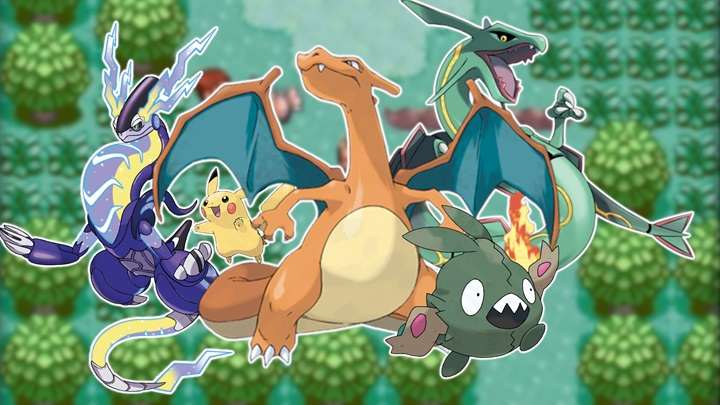The Pokémon franchise has become a cultural phenomenon since its inception, captivating millions of fans worldwide with its unique blend of adventure, strategy, and collectible creatures. From the original Pokémon Red and Blue to the latest entries in the series, Pokémon games have evolved significantly over the years. This article takes you on a journey through the Pokémon games in order, highlighting key milestones, game mechanics, and the evolution of this beloved franchise.
The Beginnings: Generation I
Pokémon Red and Blue (1996/1998)
Released in 1996 in Japan and 1998 in North America, Pokémon Red and Blue marked the beginning of the Pokémon saga. Developed for the Game Boy, these games introduced players to the world of Pokémon, where they could catch, train, and battle creatures in an effort to become the Pokémon Champion. The games featured 151 Pokémon and set the foundation for the series’ gameplay mechanics and world-building.
Pokémon Yellow: Special Pikachu Edition (1998/1999)
Building on the success of Red and Blue, Pokémon Yellow was released as a special edition that allowed players to experience the game with Pikachu as their starter Pokémon. This version was inspired by the Pokémon anime and featured a more personalized experience with Pikachu following the player character around.
Expanding Horizons: Generation II

Pokémon Gold and Silver (1999/2000)
The second generation of Pokémon games, Gold and Silver, was released for the Game Boy Color in 1999 in Japan and 2000 in North America. These games introduced 100 new Pokémon and added significant features such as a real-time clock, day/night cycles, and the ability to breed Pokémon. Players could now explore the Johto region and revisit the Kanto region from the first generation.
Pokémon Crystal (2000/2001)
Pokémon Crystal, released in 2000 in Japan and 2001 in North America, was an enhanced version of Gold and Silver. It featured improved graphics, the option to play as a female protagonist, and a new storyline involving the legendary Pokémon Suicune. Crystal also introduced the Battle Tower, where players could test their skills against other trainers.
A New Era: Generation III
Pokémon Ruby and Sapphire (2002/2003)
The third generation of Pokémon games launched with Ruby and Sapphire for the Game Boy Advance in 2002 in Japan and 2003 in North America. Set in the Hoenn region, these games introduced 135 new Pokémon and added features such as double battles and Pokémon Contests. The graphics and gameplay mechanics were significantly upgraded from previous generations.
Pokémon FireRed and LeafGreen (2004)
To commemorate the series’ success, Nintendo released Pokémon FireRed and LeafGreen in 2004 for the Game Boy Advance. These were remakes of the original Pokémon Red and Blue, featuring updated graphics and gameplay enhancements while retaining the core experience of the original games.
Pokémon Emerald (2004/2005)
Pokémon Emerald, released in 2004 in Japan and 2005 in North America, was the third installment in the Hoenn region series. It featured a new storyline involving the legendary Pokémon Rayquaza and the Battle Frontier, a new facility for challenging high-level trainers.
The Evolution Continues: Generation IV
Pokémon Diamond and Pearl (2006/2007)
The fourth generation of Pokémon games debuted with Diamond and Pearl for the Nintendo DS in 2006 in Japan and 2007 in North America. Set in the Sinnoh region, these games introduced 107 new Pokémon and new gameplay mechanics such as online trading and battling via the Nintendo Wi-Fi Connection.
Pokémon Platinum (2008/2009)
Pokémon Platinum, released in 2008 in Japan and 2009 in North America, was an enhanced version of Diamond and Pearl. It featured an expanded storyline involving the legendary Pokémon Giratina and introduced the Distortion World, a new area with unique gameplay elements.
Pokémon HeartGold and SoulSilver (2009/2010)
HeartGold and SoulSilver were remakes of the second-generation Gold and Silver games, released for the Nintendo DS in 2009 in Japan and 2010 in North America. These games combined the classic experience of the original games with updated graphics, new features, and the inclusion of a feature where Pokémon could follow the player character in-game.
A New Frontier: Generation V
Pokémon Black and White (2010/2011)
The fifth generation of Pokémon games introduced Black and White for the Nintendo DS in 2010 in Japan and 2011 in North America. Set in the Unova region, these games featured 156 new Pokémon and introduced a more complex storyline with Team Plasma as the primary antagonists. The games also added new gameplay features, such as triple battles and rotation battles.
Pokémon Black 2 and White 2 (2012)
Pokémon Black 2 and White 2 were direct sequels to Black and White, released in 2012. These games continued the story from the previous titles and introduced new Pokémon forms and locations. They also featured a new feature called the Pokémon World Tournament, where players could battle against trainers from previous games.
The Switch to 3D: Generation VI
Pokémon X and Y (2013)
Released for the Nintendo 3DS in 2013, Pokémon X and Y marked the series’ transition to 3D graphics. Set in the Kalos region, these games introduced 72 new Pokémon and the Fairy-type, as well as new gameplay features such as Mega Evolution, which allowed Pokémon to temporarily evolve during battle.
Pokémon Omega Ruby and Alpha Sapphire (2014)
Omega Ruby and Alpha Sapphire were remakes of the third-generation Ruby and Sapphire games, released for the Nintendo 3DS in 2014. They featured updated graphics, new features, and the inclusion of Mega Evolution, enhancing the original experience with modern gameplay elements.
Pokémon Sun and Moon (2016)
Pokémon Sun and Moon, released for the Nintendo 3DS in 2016, introduced the Alola region and 81 new Pokémon. These games featured new gameplay mechanics such as Alolan forms of existing Pokémon and the removal of traditional Gym Battles, replacing them with the Island Challenge.
Pokémon Ultra Sun and Ultra Moon (2017)
Released in 2017, Pokémon Ultra Sun and Ultra Moon were enhanced versions of Sun and Moon. They featured an expanded storyline, new forms of legendary Pokémon, and additional gameplay elements, offering a more comprehensive experience of the Alola region.
The Next Generation: Generation VII

Pokémon Let’s Go, Pikachu! and Let’s Go, Eevee! (2018)
Pokémon Let’s Go, Pikachu! and Let’s Go, Eevee! were released for the Nintendo Switch in 2018. These games served as a reimagining of Pokémon Yellow, incorporating gameplay elements from the mobile game Pokémon GO and offering a simplified experience for newcomers to the series.
Pokémon Sword and Shield (2019)
Pokémon Sword and Shield, released for the Nintendo Switch in 2019, introduced the Galar region and 81 new Pokémon. These games brought new features such as Dynamaxing, which allowed Pokémon to grow in size during battles, and an open-world area called the Wild Area.
Pokémon Brilliant Diamond and Shining Pearl (2021)
Brilliant Diamond and Shining Pearl were remakes of the fourth-generation Diamond and Pearl games, released for the Nintendo Switch in 2021. They featured updated graphics and quality-of-life improvements while maintaining the core experience of the original games.
Pokémon Legends: Arceus (2022)
Pokémon Legends: Arceus, released for the Nintendo Switch in 2022, marked a significant departure from traditional Pokémon gameplay. Set in the ancient Hisui region, this game introduced an open-world environment and a new approach to capturing and battling Pokémon, focusing on exploration and discovery.
Pokémon Scarlet and Violet (2022)
Released alongside Pokémon Legends: Arceus, Pokémon Scarlet and Violet also debuted in 2022. These games introduced the Paldea region and featured an open-world design with new gameplay mechanics, such as the ability to explore the world in a non-linear fashion and engage in cooperative multiplayer battles.
The Future of Pokémon Games
As of 2024, the Pokémon franchise continues to evolve, with ongoing releases and new innovations on the horizon. The series’ commitment to creativity and adaptation ensures that fans can look forward to more exciting adventures and groundbreaking gameplay experiences.
Upcoming Releases and Speculations
While details about future Pokémon games are often shrouded in secrecy, fans eagerly anticipate announcements and leaks about upcoming titles. The Pokémon Company and Game Freak have consistently demonstrated their ability to innovate while honoring the series’ rich history, making each new release a highly anticipated event.
Related Post:
Unblocked Games for School: How to Play Safely and Smartly
The Hunger Games (Film Series): A Dystopian Masterpiece
Exploring the Best Oculus Quest 2 Games: A Comprehensive Guide
The Pokémon series has come a long way since its humble beginnings with Pokémon Red and Blue. With each new generation, the franchise has introduced new Pokémon, gameplay mechanics, and regions, keeping fans engaged and excited. Whether you’re a longtime fan or a newcomer to the series, understanding the chronological progression of Pokémon games provides insight into the evolution of this iconic franchise. As Pokémon continues to grow and innovate, one thing remains certain: the adventure is far from over.


